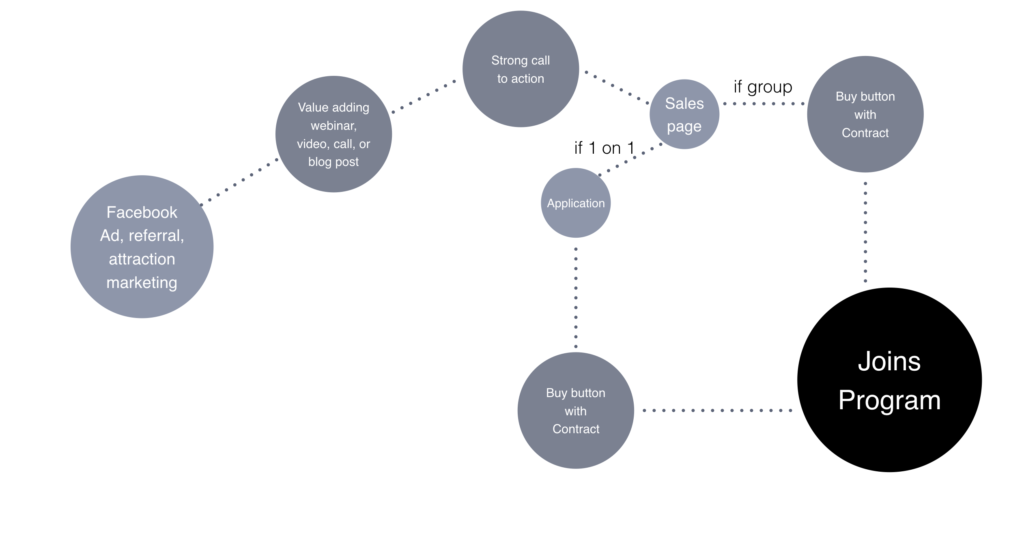This post is all about coaching business plan.
 If you’re a coach or a consultant looking to start or grow your coaching business, one of the biggest challenges you’ll face is figuring out how to get more clients.
If you’re a coach or a consultant looking to start or grow your coaching business, one of the biggest challenges you’ll face is figuring out how to get more clients.
With so many different marketing channels to choose from, it can be hard to know where to focus your efforts.
In this post, we’ll take a look at some of the most effective ways to get coaching clients, including using social media, webinars, email marketing, and automated sales funnels.
I have created this detailed post to share with you the top tips and strategies that have helped me grow my coaching business online to clients in over 100 niches who live in 20+ countries and I know it can help you too!
Coaching Business Plan
One of the most powerful tools for promoting your coaching business is social media. Platforms like Facebook, Instagram, and LinkedIn are a great way to connect with potential clients, build your brand, and share your expertise.
To get the most out of your social media efforts, it’s important to be consistent and strategic. This means posting regularly and targeting your content to specific segments of your audience. For example, if you specialize in career coaching, you might focus on creating content that resonates with job seekers and working professionals.
Social media is a powerful tool for promoting your coaching business and connecting with potential clients. Platforms like Facebook, Instagram, and LinkedIn offer a variety of features that you can use to build your brand, share your expertise, and reach out to potential clients. In this post, we will explore how you can use social media to get more coaching clients for your coaching business plan.
Step 1: Define Your Target Audience
The first step in using social media to get coaching clients is to define your target audience. Knowing who your ideal client is will help you create content that resonates with them, which will make it more likely that they will be interested in working with you. Consider factors such as their age, gender, income, location, interests, and pain points. Once you have a clear picture of your ideal client, you can start creating content that speaks directly to them.
Step 2: Create a Social Media Strategy
Once you have defined your target audience, the next step is to create a social media strategy. A social media strategy will help you stay focused and consistent with your efforts, which is key to getting results. Consider what type of content you will create, how often you will post, which platforms you will use, and how you will measure success.
Step 3: Optimize Your Social Media Profiles
Your social media profiles are the first point of contact potential clients will have with your business, so it’s important to make sure they are professional, engaging and up-to-date. Make sure your profile picture and bio accurately represents you and your business, and includes relevant keywords to increase visibility.
Step 4: Create High-Quality, Engaging Content
Creating high-quality, engaging content is essential to getting more coaching clients. Use your social media profiles to share valuable insights, tips, and advice that will help your target audience. Consider using a mix of different types of content such as text, images, and videos to keep your followers engaged. Keep in mind the best time to post on each social media platform for better visibility and engagement.
Step 5: Use Paid Advertising
While organic reach on social media can be limited, using paid advertising can help you reach a larger audience. Platforms like Facebook and Instagram offer a variety of ad formats that you can use to target your ideal clients. Consider running ads to promote your services, webinars, or other lead magnets that will help you generate leads.
Step 6: Connect and Engage with Your Audience
Social media is a two-way conversation, so it’s important to connect and engage with your audience. Respond to comments, messages and reviews promptly, create polls and surveys to get feedback, and use social listening tools to monitor and join conversations relevant to your business. Building relationships with your followers will increase the likelihood that they will recommend your business to others.
Step 7: Measure and Analyze
Finally, it’s important to measure and analyze your social media efforts. Use analytics tools to track engagement, reach, and conversion rates. Use this data to see what is working and what is not, and adjust your strategy accordingly.
In conclusion, social media can be a powerful tool for getting more coaching clients, but it’s important to approach it in a strategic and consistent way. By defining your target audience, creating a social media strategy, optimizing your social media profiles, creating high-quality, engaging content, using paid advertising, connecting and engaging with your audience, and measuring and analyzing your efforts, you can increase your visibility and credibility, generate leads, and ultimately grow your coaching business.
Here is an example from my own coaching business:
View this post on Instagram
Webinars For Coaches:
Webinars are another great way to promote your coaching business and connect with potential clients. They provide an opportunity to share your expertise and demonstrate your value in a format that is both engaging and interactive.
When it comes to organizing a webinar, there are a few key things to keep in mind. First, you’ll want to choose a topic that is relevant and valuable to your target audience. Second, you’ll need to create a landing page and registration page to promote your webinar and collect sign-ups. Finally, you’ll want to use email marketing to follow-up with attendees and offer them a chance to work with you one-on-one.
Webinars are an effective marketing tool for coaches and consultants looking to attract new clients and grow their coaching business. They offer an opportunity to share your expertise, demonstrate your value, and connect with potential clients in an interactive and engaging format. In this post, we will explore how you can use webinars to get more coaching clients for your coaching business plan.
Step 1: Define Your Target Audience
The first step in using webinars to get coaching clients is to define your target audience. Knowing who your ideal client is will help you create a webinar that resonates with them, making it more likely that they will be interested in working with you. Consider factors such as their age, gender, income, location, interests, and pain points. Once you have a clear picture of your ideal client, you can start creating content that speaks directly to them.
Step 2: Choose an Engaging Topic
The topic of your webinar should be relevant and valuable to your target audience. Choose a topic that addresses a specific problem or challenge that your ideal client is facing and that you have expertise on. For example, if you specialize in career coaching, you might choose a topic like “How to land your dream job in 30 days”.
Step 3: Promote Your Webinar
Once you have defined your target audience and chosen an engaging topic, the next step is to promote your webinar. You can use social media, email marketing, and other marketing channels to reach your target audience and get them to register for your webinar. Be sure to create a landing page and registration page that clearly explain the benefits of attending your webinar.
Step 4: Prepare Your Presentation
When preparing your webinar presentation, make sure to keep it engaging and interactive. Use multimedia elements such as images, videos, and polls to keep your audience interested. Also, consider using a slide-sharing platform like Slideshare or Google Slides to make it easy to share your presentation with your audience.
Step 5: Host Your Webinar
When hosting your webinar, make sure to be prepared and professional. Test your technology and make sure everything is working properly. Also, make sure you have a backup plan in case of technical difficulties.
Step 6: Follow-Up with Attendees
After your webinar, it’s important to follow-up with attendees. Use email marketing to send out a thank you email, and offer them a chance to work with you one-on-one. This can be done through a free consultation call, or special offer for your coaching services. Be sure to include a clear call to action in your follow-up email, so it’s easy for attendees to take the next step.
Step 7: Analyze and Improve
Finally, it’s important to analyze and improve your webinars. Keep track of your registration and attendance numbers, as well as feedback from attendees. Use this data to see what worked well and what didn’t, and adjust your strategy accordingly.
In conclusion, using webinars as a marketing tool for your coaching business can be an effective way to connect with potential clients and generate leads. By defining your target audience, choosing an engaging topic, promoting your webinar, preparing your presentation, hosting your webinar professionally, following-up with attendees and analyzing the result, you can increase your visibility and credibility, generate leads, and ultimately grow your coaching business.
Here is an example of how it all works together:

Email Marketing for Coaches:
Email marketing is another powerful tool for getting coaching clients. By building a list of email subscribers, you can stay in touch with potential clients and keep them engaged with your business.
When it comes to email marketing, there are a few key things to keep in mind. First, you’ll want to create a welcome series that sets the right tone and sets expectations for future emails. Second, you’ll want to segment your list and create different email campaigns for different segments of your audience. And finally, you’ll want to use email automation to trigger personalized emails based on specific actions or behaviors.
Email marketing can be an effective way to generate leads and acquire coaching clients for your business. Here are some tips on how to use email marketing to attract and convert potential clients for your coaching business:
- Build an email list: Start by collecting email addresses from potential clients and building a list of contacts. You can do this by offering a free resource, such as a guide or an e-book, in exchange for an email address. Once you have a list of contacts, you can start sending targeted and personalized communications to them.
- Segment your email list: Once you have a list of contacts, segment them based on their interests, needs, and behavior. This will allow you to tailor your messages and offers to specific groups of people, which will increase their relevance and effectiveness.
- Create valuable content: One of the most important things to keep in mind when creating your email marketing campaigns is to provide value to your subscribers. Share your coaching expertise, tips, and advice in your emails. Send them valuable information that they can use to improve their lives. This way, you will be viewed as a trusted advisor, which will make them more likely to become paying clients.
- Use persuasive language: The language you use in your emails is just as important as the content you share. Use persuasive language to encourage your subscribers to take action. Make sure to include a clear call-to-action in your emails, such as “Book a free consultation” or “Sign up for our coaching program.”
- Personalize your emails: Personalization can make a big impact on the effectiveness of your email marketing campaigns. Use the subscriber’s name in the subject line and body of the email, and send them targeted and personalized messages. This will help you to establish a relationship with your subscribers, which will increase their trust and likelihood to become a client.
- Optimize for mobile: With the increasing use of mobile devices to check emails, it is important to optimize your emails for mobile devices. This includes using a responsive design, short paragraphs, and larger font sizes.
- Track and analyze your results: It is important to track and analyze the results of your email marketing campaigns so that you can optimize your strategy. Use tools like Google Analytics to track email opens and click-through rates. Analyze this data to understand what is working and what isn’t, and use this information to make data-driven decisions about your email marketing strategy.
- Follow up with your subscribers: Following up with your subscribers is crucial to turning them into paying clients. Set up automated email sequences that continue to nurture your relationship with your subscribers and encourage them to take action. Send them follow-up emails after they have taken a specific action, such as booking a consultation, to remind them of your services and the benefits they will receive from working with you.
By following these tips, you can use email marketing to generate leads and acquire coaching clients for your business. Remember that the key to success is providing value, building relationships, and being persistent in your efforts. Continuously refine and optimize your email marketing strategy, and you will be able to consistently grow your coaching business.
Automated Sales Funnels For Coaches:
An automated sales funnel is a series of steps that guide potential clients through the process of working with you. It can be used to generate leads, nurture relationships, and convert leads into paying clients.
One of the keys to creating an effective automated sales funnel is to focus on the customer’s journey. This means thinking about the specific needs and challenges of your target audience, and then designing your funnel to address those needs and overcome those challenges.
An automated sales funnel is a powerful tool that can help you acquire coaching clients for your business. A sales funnel is a series of steps that guide potential clients through the process of becoming paying customers. By using an automated sales funnel, you can streamline this process and make it more efficient and effective.
Here are some tips on how to use automated sales funnels to acquire coaching clients for your business:
- Define your target audience: Before you can create an effective sales funnel, you need to know who your target audience is. Understand the demographics, psychographics, pain points, and goals of your ideal client. This will help you to create a sales funnel that is tailored to their specific needs and preferences.
- Create a lead magnet: The first step in your sales funnel is to attract potential clients to your business. A lead magnet is an irresistible offer, such as a free resource or a special discount, that entices people to give you their contact information in exchange for something valuable.
- Use a landing page: After someone clicks on your lead magnet, they should be directed to a landing page. This is a specific page on your website that is designed to convert visitors into leads. Your landing page should include a form to capture their contact information, as well as a clear and compelling message that tells them what they will get by signing up.
- Send follow-up emails: Once you have collected someone’s contact information, the next step is to send them follow-up emails. These emails should continue to provide value, build trust, and encourage them to take the next step in your sales funnel. For example, you could send them an email that includes a link to a free webinar or an invite to schedule a free consultation.
- Nurture your leads: The ultimate goal of your automated sales funnel is to convert leads into paying clients. To do this, you need to continue to nurture your leads with relevant and valuable content. Send them regular emails with tips, advice, and case studies to demonstrate your expertise and authority.
- Offer a low-commitment package: One way to convert leads into paying clients is to offer them a low-commitment package. This could be a discovery session, a one-on-one coaching session or a trial package. The idea behind this is that it allows the potential client to test the waters, before committing to a full coaching program.
- Use retargeting ads: Retargeting ads are a powerful way to bring people back to your sales funnel who have dropped off at some point. These are ads that are shown to people who have visited your website but haven’t taken the desired action. Use retargeting ads to remind them of your offer and encourage them to take the next step in your sales funnel.
- Test and optimize: One of the key benefits of an automated sales funnel is that it can be easily tested and optimized. Use tools like Google Analytics to track how many people are entering your sales funnel, at which point they’re dropping off and what they’re clicking on. Use this data to make data-driven decisions about how to improve your sales funnel, and continually test and optimize different elements of your funnel to improve conversions.
By following these tips, you can use automated sales funnels to acquire coaching clients for your business. Remember that the key to success is providing value, building trust, and continually testing and optimizing your sales funnel. With an effective automated sales funnel, you can streamline the process of acquiring clients and scale your coaching business.
Overall, having a solid coaching business plan is crucial for attracting new clients, and using a combination of social media, webinars, email marketing, and automated sales funnels can be an effective way to achieve that. By taking a holistic approach, you’ll be able to build relationships and demonstrate your value to potential clients, which will ultimately lead to more clients and more revenue for your coaching business.






